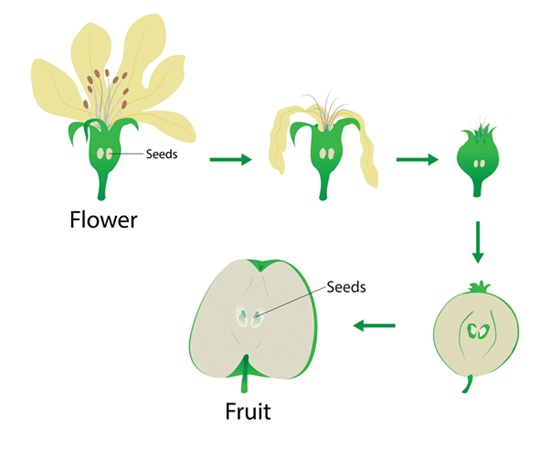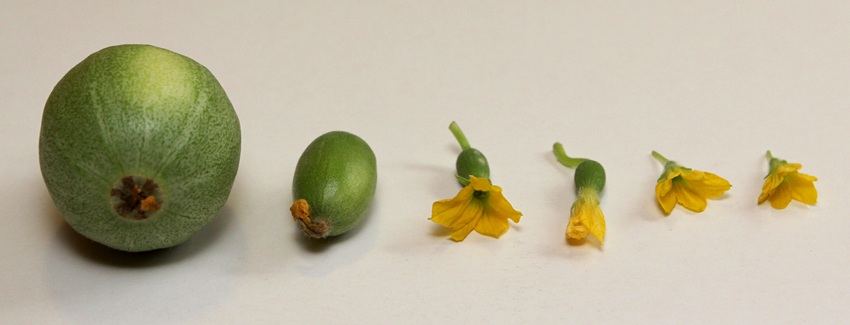
Everything About the Process of Flower to Fruit Conversion
The transformation from flower to fruit is a complex and essential biological process in plants. It plays a crucial role in producing both edible and non-edible fruits, supporting agriculture, ecosystems, and food security worldwide. In this detailed guide, we’ll break down the various stages of how flowers turn into fruits. We’ll also cover the key hormones involved and the environmental conditions that can impact this process. Whether you’re a farmer managing orchards or a gardener looking to boost yields, understanding these elements can help optimize fruit production. We’ll provide practical insights to make this information actionable and relevant for modern agriculture.
This process isn’t just about nature taking its course; it’s influenced by factors like pollination, nutrition, and weather. By addressing common challenges, such as flower drop, you can improve fruit set and overall harvest quality. Let’s dive in to explore why some flowers fail to become fruits and how to enhance success rates.
Why Flowers Drop and Fail to Become Fruits
The conversion from flower to fruit is a natural sequence that begins with pollination and ends with fruit formation. For blossoms to successfully develop into fruits, ideal environmental conditions are essential. Factors like appropriate temperature, humidity, and sufficient light are critical, as they support the plant’s energy needs during this phase. Additionally, the nutrients available to the plant or tree directly affect the quality of this transformation.
In many trees and plants, an abundance of flowers is common, but not all can mature into fruits due to resource limitations. Genetically, the plant sheds some flowers to maintain balance, retaining only the strongest ones for fruit development. This natural thinning is normal and helps ensure the surviving fruits receive adequate resources.
However, excessive flower drop beyond standard levels can reduce orchard productivity, leaving few fruits behind. To combat this, farmers must identify the underlying causes and adjust conditions accordingly. This proactive approach can lead to higher yields in subsequent seasons.
Several factors contribute to flower drop in trees and plants. Common reasons include:
- Inadequate pollination
- Incorrect fertilization and poor nutrition
- Improper watering
- Pest and disease attacks
- Adverse environmental conditions (such as strong winds, spring frosts, extreme heat, high humidity, or hail)
- Genetic weaknesses or unsuitable varieties
- Hormonal imbalances
Additional triggers like excessive or insufficient fertilizer, herbicide exposure, excess moisture, sudden temperature shifts, high temperatures, or intense light can exacerbate flower and fruit drop. In fruit trees, poor pollination often stems from a lack of cross-pollination, which is vital for most species to set a successful crop. Frost damage is another major culprit, as fruit tree flowers are highly sensitive to late spring freezes. These insights highlight the need for vigilant monitoring and timely interventions to minimize losses.

What Are the Stages of Flower to Fruit Conversion in Plants?
The flower serves as the reproductive organ of the plant, transforming into fruit after pollination and fertilization. This process unfolds in several distinct steps, each building on the previous one to ensure successful reproduction.
- Bud Formation and Blooming: The process starts with the formation of flower buds and their opening. Without proper bud development, no fruits can form. As buds emerge, adjust nutrition and watering to match this stage’s demands. Environmental cues like photoperiod (day length) and temperature influence this induction, as noted in floral biology research.
- Pollen Transfer from Stamen to Stigma (Pollination): Pollen grains move from the male stamen to the female stigma. This can occur via wind, insects, birds, or human assistance. If pollination fails, fertilization doesn’t happen, and the flower drops instead of developing into fruit.
- Pollen Germination and Tube Growth to the Ovule (Fertilization): Once pollen lands on the stigma, a pollen tube grows down to the ovule. Here, male and female gametes fuse, forming a fertilized ovule.
- Ovary to Fruit and Ovules to Seeds: Post-fertilization, the flower’s structure changes. The ovary enlarges into the fruit, while the ovules become seeds. Petals and stamens wither and fall away.
- Fruit Growth: After fertilization, the plant’s metabolism shifts, directing nutrients and energy toward the ovary. Hormones like auxins and gibberellins increase, promoting cell enlargement and tissue formation. The fruit develops layers such as skin, flesh, and seeds. Depending on the plant and conditions, this can take weeks to months.

Fruit development involves three basic phases: ovary development and cell division (fruit set), cell expansion, and maturation/ripening, as described in scientific overviews. In flowering plants, the mature ovary becomes the fruit, encapsulating seeds for dispersal. Environmental factors like light and gravity also influence growth by affecting hormone distribution. For optimal outcomes, maintain consistent conditions throughout these stages to support robust fruit formation.
What Role Do Hormones Play in Fruit Formation?
Hormones are vital regulators in the flower-to-fruit process, orchestrating cellular changes and growth responses. The primary hormones involved include:
- Auxin: This hormone is key during fertilization and fruit formation. It stimulates fruit development, prevents premature drop, and aids nutrient transport to growing fruits. Auxins promote cell elongation, essential for plant responses to environmental changes.
- Gibberellin: Gibberellin drives fruit growth and size increase, also aiding seed germination. It works synergistically with other hormones to enhance cell division and expansion.
- Ethylene: As a natural gas, ethylene governs fruit ripening, inducing changes like softening and color shifts. It can also trigger flower and fruit drop if levels are imbalanced.
- Cytokinin: Cytokinin promotes cell division in developing fruits, maintaining growth balance alongside auxin.
These hormones interact to ensure proper development, with environmental factors influencing their production and activity. Imbalances can lead to issues like excessive drop, underscoring the importance of stable conditions.
Main Reasons Flowers Don’t Turn into Fruits
Even with abundant flowers, fruit formation may fail due to:
- Incomplete pollination or absence of pollinators (e.g., bees)
- Unsuitable temperatures during blooming
- Deficiencies in macro- and micronutrients
- Plant stress from water issues or pests
- Insufficient growth hormones or improper balances
Genetic and environmental factors, including photoperiod, further affect flowering and fruit set. Misuse of growth regulators or pesticides can also cause abortion. Addressing these early prevents yield losses.
How to Boost the Flower-to-Fruit Conversion Rate
To improve fruit set success, follow these strategies:
- Provide Pollinators in the Orchard: Pollination is pivotal, directly affecting conversion rates. Adverse weather or over-spraying can reduce pollinator activity, leading to drop. Place beehives during bloom to enhance natural pollination, increasing fruit set.
- Consistent Watering: Regular irrigation prevents soil dryness, which causes wilting and dropping. Tailor schedules to tree needs, avoiding waterlogging. Proper moisture sustains flower health and stabilizes fruit development.
- Balanced Nutrition: Essential elements like potassium, boron, and zinc prevent weaknesses. Plan feeding around bloom to supply energy for fruit growth, boosting conversion percentages.
- Favorable Environmental Conditions: Key factors include:
- Temperature: Low temps hinder pollination; excessive heat dries stigmas.
- Humidity: Optimal levels support pollen tube growth; extremes disrupt it.
- Light: Adequate sunlight boosts photosynthesis for fruit energy.
- Wind: Strong winds or sudden colds cause drop. Use windbreaks, light watering before freezes, heaters, or covers in cold areas. Choose late-blooming, cold-resistant varieties.
- Foliar Hormone Sprays During Bloom: Apply auxins and gibberellins under expert guidance to stabilize flowers and stimulate fruiting. Incorrect use can backfire.
- Pest and Disease Management: These weaken trees and damage flowers. Regular monitoring, proper pruning, and targeted spraying maintain health, aiding fruit set.

Integrating these, as recommended by Penn State Extension, can significantly reduce the drop from frost or pests.
The Role of Fertilization in Fruit Formation
Proper and timely fertilization is one of the most important factors in successful flower-to-fruit conversion. Elements like boron, zinc, potassium, calcium, and iron play positive roles in fruit set. Apply these based on the tree’s needs and timing. Boron, in particular, is crucial for healthy fruits and can be applied during bloom.
During blooming, halt certain fertilizers, especially nitrogen-based fertilizers. Nitrogen is vital for vegetative growth, but should be applied before bud break. Using it during bud swell or bloom can cause drop. Fertilize 4-6 weeks before bloom to allow nutrient absorption.
A balanced, organic fertilizer program from pre-bloom to fruit set improves nutrition, stress resistance, and conversion rates. To create an effective plan, conduct soil tests before the growing season. These reveal deficiencies, enabling precise applications for optimal growth.
For nitrogen needs, consider ammonium sulfate fertilizer, which provides nitrogen and sulfur. It’s ideal for pre-bloom applications in alkaline soils, supporting vegetative prep without risking drop during flowering. It is early spring. This ensures trees have the foundation for strong fruit set.
In summary, mastering the flower-to-fruit process involves balancing biology, environment, and management. By applying these principles, you can enhance yields and fruit quality. For high-quality ammonium sulfate fertilizer to support your pre-bloom nutrition, explore reliable suppliers focused on agricultural success.